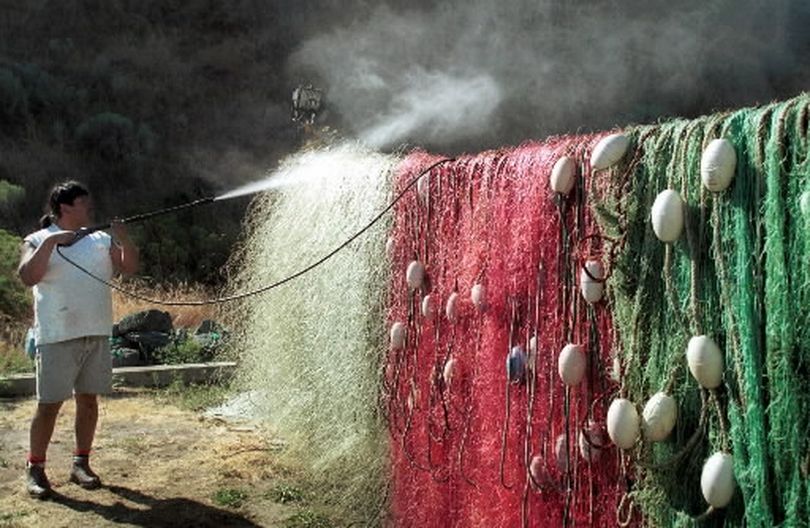Oregon governor seeks peace as salmon gillnetting issue heats up

FISHING -- Trying to head off a ballot measure to ban gillnetting for salmon on the Oregon side of the lower Columbia River, Gov. John Kitzhaber has told state fisheries managers to come up with new regulations that would accomplish a similar goal while still keeping gillnetters on the water.
Sportfishermen like the idea of getting gillnets off the lower Columbia.
The governor’s plan landed with a thud for gillnetters, who said there is no way the state can produce enough hatchery fish to make up for the loss of the high quality wild fish they catch in the main channel or mainstem.
They get $3 a pound for wild fish caught in the main channel, but only 75 cents a pound for hatchery fish they catch in places like Youngs Bay, where hatchery salmon are released specifically for commercial harvest.
Read on for more details in a story by the Associated Press.
By JEFF BARNARD
AP Environmental Writer
Trying to head off a ballot measure to ban gillnetting for salmon on the Oregon side of the lower Columbia River, Gov. John Kitzhaber has told state fisheries managers to come up with new regulations that would accomplish a similar goal while still keeping gillnetters on the water.
At the governor’s behest, the Oregon Fish and Wildlife Commission on Tuesday directed state fisheries managers to develop regulations that relegate commercial gillnetters to side bays and channels of the Columbia below Bonneville Dam. In return, state salmon hatcheries would increase production just for them.
That would leave the main channel of the lower Columbia to sports anglers, giving them more fish to catch under restrictions intended to protect the 13 runs of threatened and endangered salmon.
The Columbia basin’s salmon runs have been declining for more than a century from habitat loss to dam construction, logging, agriculture and urban development, as well as overharvest and misguided attempts to replace wild fish with fish raised in hatcheries. Thirteen separate runs are now protected by the Endangered Species Act, and the great bulk of salmon are raised in hatcheries. Restrictions on gillnetters have been getting progressively tighter since the 1960s. The Oregon gillnet fleet now amounts to about 150 boats, which landed fish that sold for about $3 million last year.
The governor’s plan landed with a thud for gillnetters, who said there is no way the state can produce enough hatchery fish to make up for the loss of the high quality wild fish they catch in the main channel or mainstem.
Gillnetter Jim Wells, president of the group Salmon For All, said they get $3 a pound for wild fish caught in the main channel, but only 75 cents a pound for hatchery fish they catch in places like Youngs Bay, where hatchery salmon are released specifically for commercial harvest. Besides, the state does not have the funding or hatchery capacity to significantly increase production of young salmon, without taking them from the Willamette River, where Portland sports fishermen would howl in opposition.
Wells added that taking gillnetters off the mainstem will not allow any more threatened and endangered fish to survive to spawn, because the allowances they currently get to kill protected fish would be transferred to sports anglers.
“He’s going to have a real problem selling this,” Wells said of the governor.
Liz Hamilton, executive director of the Northwest Sport Fishing Industry Association, said federal fisheries managers proposed in 1994 to get gillnetters out of the mainstem by 2002, and created the side channel fisheries to make up for the change.
“The first part of that promise was kept, but the second part wasn’t she said.
Hamilton added that gillnetters took 100,000 hatchery fish from those special fisheries, far more than all the fish taken from the mainstem by sports fishermen.
“It already is out of balance with numbers of fish,” she said.
The plan is to phase in the changes over the next three to five years, the time it would take young salmon to migrate to the ocean, grow to adulthood, and return to the river. The governor urged the commission to adopt the rules before the end of the year, and apply them to both salmon and sturgeon.
In a letter to the commission, Kitzhaber wrote that he hoped to end decades of conflict over sharing the Columbia’s salmon fishery, while improving the chances for restoring struggling salmon runs.
“I believe the use of gill nets in non-tribal mainstem fisheries is inconsistent with this objective,” he wrote. “I also believe the long-term solution must enhance the economic vitality of both recreational and commercial fisheries, which provide the public with benefits including recreation, family-wage jobs and businesses, local commerce and export economies, nationally renowned culinary destinations, and the Pacific Northwest’s uniquely high quality of life and culture.”
Just how salmon hatchery production would be increased, and what new harvest areas would be created for gillnetters, will be worked out over the next three months and presented to the commission, said Curt Melcher, deputy director of the Oregon Department of Fish and Wildlife.
On the Washington side of the river, Department of Fish and Wildlife Regional Director Guy Norman said they hoped to work out a way to keep Washington’s regulations compatible with Oregon’s, but reserved the right to go their own way.
The governor’s proposal comes as sports fishing and conservation groups try to convince voters to support Ballot Measure 81, which would ban gillnetting from the Columbia, except by tribal fishermen. It would allow commercial fishing with seine nets.
Supporters argue it would stop a harvest method that makes it difficult to release threatened and endangered fish unharmed, and also takes a toll on birds and other wildlife.
